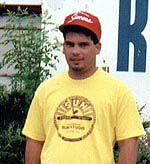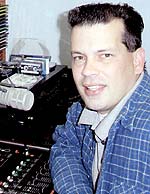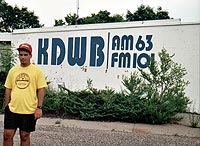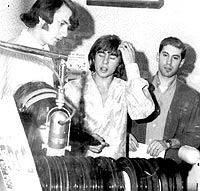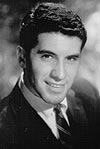The David Adams Collection
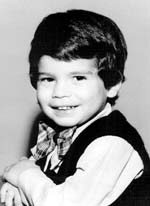
David Adams, Age 4.
|
As the son of Bob Shannon, I guess you could say I was born into radio on April 2, 1971. Anyway, it certainly didn't hurt.
My first on-air experience was at KDWB Minneapolis/St.Paul, when the legendary Wolfman Jack picked me to voice a series of promos for his syndicated show. The line? "Wolfman Jack is a gas!". I was just four years old, and he didn't pay me a dime. Talk about violating the child labor laws... But my first actual paid job came at the age of five when I co-hosted a KFI remote with my dad live from the L.A. County Fair in the spring of 1976. Since then, my journey into radio has taken me to KSBR in Orange County, News/Talk KRLA and History Quest Productions where I co-produce and narrate documentaries . A few years ago I came across an enormous collection of airchecks in the production room labeled "Shannon", and discovered a few hidden treasures treasures including a station composite of KDWB and the "Monkees at KRUX". The collection also included a collection of tapes labeled the "Shannons of Top Forty Radio" which included Tom, Bob and Don. Enjoy!! |
The Repository thanks David Adams for sharing!
Unscoped
The aircheck is a (partially restored) 45-minute composite of the two and a half hours that Michael Nesmith, Mickey Dolenz and Davy Jones actually ran the control board, spun the records and played all the commercials themselves. (Peter Tork wasn’t feeling well and stayed at the hotel.) On a more personal note, not only was my dad featured in this episode, but my mom was too. Strangely, neither of them knew each other at the time, but whatever it was that finally brought them together, I’ll be forever grateful!
It was also during this show that the Monkees invited the entire city of Phoenix to join them at the prestigious Mountain Shadows Hotel for an open party later that night. Panic-stricken executives from both the radio station and hotel quickly pressured the group to recant their invitation. In an effort to avoid a disaster and bring some levity to the situation, Mike Nesmith is heard conducting an interview with the hotel manager, played by Bob Shannon.
This aircheck may represent the first appearance of The Monkees performing collectively as Top Forty jocks. The concert, emceed by Shannon and the KRUX Good Guys, was held the following night at the Phoenix Coliseum on January 21, 1967. It marked the Monkees’ first concert appearance, and the final episode of their 1966 TV Season.

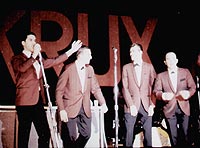
Scoped
[Description by contributor David Adams]
This gem was hidden away in a box marked “Specials”, and not only includes an aircheck of The Monkees taking over the Bob Shannon Show at KRUX, but it’s also an aircheck of the final episode of the Monkees very successful first season. The episode was titled “The Monkees on Tour”, and it begins with their arrival at Phoenix’s Sky Harbor to the screams of thousands of hysterical teens. On the following night the infamous Monkee mobile is seen racing across town to KRUX. They storm the control room before binding and gagging the city’s most popular DJ, Bob Shannon.
The aircheck is a (partially restored) 45-minute composite of the two and a half hours that Michael Nesmith, Mickey Dolenz and Davy Jones actually ran the control board, spun the records and played all the commercials themselves. (Peter Tork wasn’t feeling well and stayed at the hotel.) On a more personal note, not only was my dad featured in this episode, but my mom was too. Strangely, neither of them knew each other at the time, but whatever it was that finally brought them together, I’ll be forever grateful!
It was also during this show that the Monkees invited the entire city of Phoenix to join them at the prestigious Mountain Shadows Hotel for an open party later that night. Panic-stricken executives from both the radio station and hotel quickly pressured the group to recant their invitation.
In an effort to avoid a disaster and bring some levity to the situation, Mike Nesmith is heard conducting
an interview with the hotel manager, played by Bob Shannon.
This aircheck may represent the first appearance of The Monkees performing collectively as Top Forty jocks. The concert, emceed by Shannon and the KRUX Good Guys, was held the following night at the Phoenix Coliseum on January 21, 1967. It marked the Monkees’ first concert appearance, and the final episode of their 1966 TV Season.


Unscoped
This Exhibit ‘SCOPED (03:22)
All reportable music performances have been removed. Please remember that in addition to music licensing fees for the mostly UNSCOPED version, there are bandwidth and hardware costs for this ‘SCOPED version, and anything streamed from REELRADIO. We welcome your support.
Don Bombard was a hometown boy who spent his first 14 years in radio working at his favorite radio stations, WOLF and WNDR. His upbeat, friendly style is clearly illustrated in this restored, composite aircheck from the spring and summer of 1969.
Don also spent several years at 13Q Pittsburgh before joining WCBS-FM in New York City, where he became known as Bob Shannon while working for Program Director Joe McCoy.
Scoped
Scoped
Unscoped
Unscoped
[Description by contributor David Adams]
When Don Bombard began doing afternoon drive at WCBS-FM in New York, PD Joe McCoy suggested he call himself Bob Shannon. He quickly became one of New York’s best known DJs. According to Don, “my namesake was yet another “Bob Shannon” who worked for the TM Century production company!” (as of June, 2006, that “Bob Shannon” is on the Board of Directors of REELRADIO, Inc..)
The first Bob Shannon in the radio business was Bob “Shamrock” Shannon (d. 08-15-2000), the longtime radio and TV announcer who worked for the CBS network in the 1940s and 1950s.
Don’s introduction to oldies came in Pittsburgh, Pennsylvania at the former 13Q (WKTQ) with his Sunday Night Oldies Party. At the time, he couldn’t have known that the Oldies Party was a warm-up to a twenty year career in afternoon drive at WCBS-FM.
Thanks to Don Bombard, Rob Frankel and Tom Buck for assistance in restoring the music to this REELRADIO exhibit. ALL REELRADIO exhibits are copyrighted by REELRADIO, Inc. as of the date of publication and are licensed for real-time streaming, only. Do NOT duplicate, trade, or sell this copyrighted recording.]
Scoped
[Description by contributor David Adams]
When Don Bombard began doing afternoon drive at WCBS-FM in New York, PD Joe McCoy suggested he call himself Bob Shannon. He quickly became one of New York’s best known DJs. According to Don, “my namesake was yet another “Bob Shannon” who worked for the TM Century production company!” (as of June, 2006, that “Bob Shannon” is on the Board of Directors of REELRADIO, Inc..)
The first Bob Shannon in the radio business was Bob “Shamrock” Shannon (d. 08-15-2000), the longtime radio and TV announcer who worked for the CBS network in the 1940s and 1950s.
Don’s introduction to oldies came in Pittsburgh, Pennsylvania at the former 13Q (WKTQ) with his Sunday Night Oldies Party. At the time, he couldn’t have known that the Oldies Party was a warm-up to a twenty year career in afternoon drive at WCBS-FM.
Thanks to Don Bombard, Rob Frankel and Tom Buck for assistance in restoring the music to this REELRADIO exhibit. ALL REELRADIO exhibits are copyrighted by REELRADIO, Inc. as of the date of publication and are licensed for real-time streaming, only. Do NOT duplicate, trade, or sell this copyrighted recording.]

